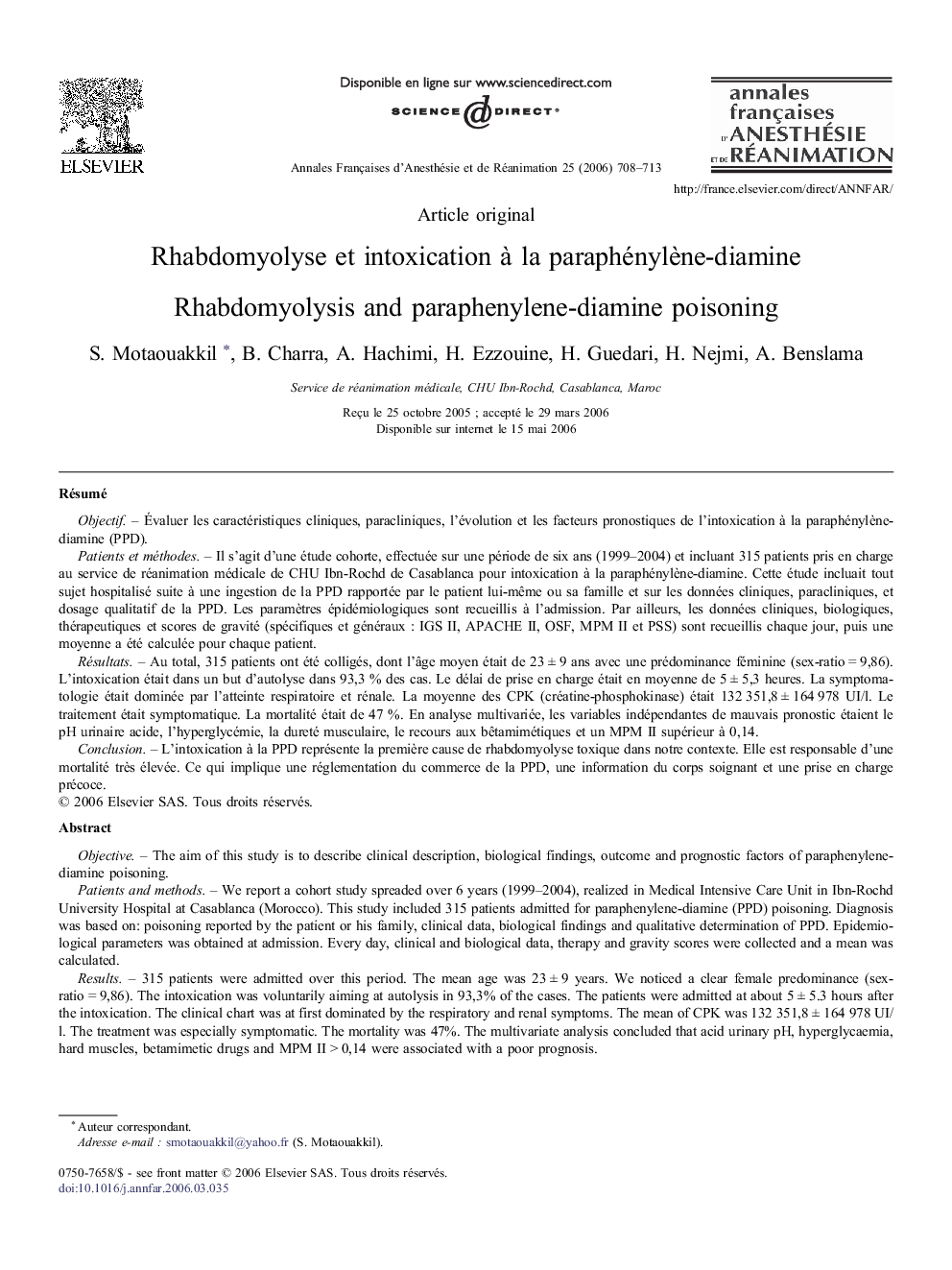| کد مقاله | کد نشریه | سال انتشار | مقاله انگلیسی | نسخه تمام متن |
|---|---|---|---|---|
| 2748262 | 1148966 | 2006 | 6 صفحه PDF | دانلود رایگان |

RésuméObjectifÉvaluer les caractéristiques cliniques, paracliniques, l'évolution et les facteurs pronostiques de l'intoxication à la paraphénylène-diamine (PPD).Patients et méthodesIl s'agit d'une étude cohorte, effectuée sur une période de six ans (1999–2004) et incluant 315 patients pris en charge au service de réanimation médicale de CHU Ibn-Rochd de Casablanca pour intoxication à la paraphénylène-diamine. Cette étude incluait tout sujet hospitalisé suite à une ingestion de la PPD rapportée par le patient lui-même ou sa famille et sur les données cliniques, paracliniques, et dosage qualitatif de la PPD. Les paramètres épidémiologiques sont recueillis à l'admission. Par ailleurs, les données cliniques, biologiques, thérapeutiques et scores de gravité (spécifiques et généraux : IGS II, APACHE II, OSF, MPM II et PSS) sont recueillis chaque jour, puis une moyenne a été calculée pour chaque patient.RésultatsAu total, 315 patients ont été colligés, dont l'âge moyen était de 23 ± 9 ans avec une prédominance féminine (sex-ratio = 9,86). L'intoxication était dans un but d'autolyse dans 93,3 % des cas. Le délai de prise en charge était en moyenne de 5 ± 5,3 heures. La symptomatologie était dominée par l'atteinte respiratoire et rénale. La moyenne des CPK (créatine-phosphokinase) était 132 351,8 ± 164 978 UI/l. Le traitement était symptomatique. La mortalité était de 47 %. En analyse multivariée, les variables indépendantes de mauvais pronostic étaient le pH urinaire acide, l'hyperglycémie, la dureté musculaire, le recours aux bêtamimétiques et un MPM II supérieur à 0,14.ConclusionL'intoxication à la PPD représente la première cause de rhabdomyolyse toxique dans notre contexte. Elle est responsable d'une mortalité très élevée. Ce qui implique une réglementation du commerce de la PPD, une information du corps soignant et une prise en charge précoce.
ObjectiveThe aim of this study is to describe clinical description, biological findings, outcome and prognostic factors of paraphenylene-diamine poisoning.Patients and methodsWe report a cohort study spreaded over 6 years (1999–2004), realized in Medical Intensive Care Unit in Ibn-Rochd University Hospital at Casablanca (Morocco). This study included 315 patients admitted for paraphenylene-diamine (PPD) poisoning. Diagnosis was based on: poisoning reported by the patient or his family, clinical data, biological findings and qualitative determination of PPD. Epidemiological parameters was obtained at admission. Every day, clinical and biological data, therapy and gravity scores were collected and a mean was calculated.Results315 patients were admitted over this period. The mean age was 23 ± 9 years. We noticed a clear female predominance (sex-ratio = 9,86). The intoxication was voluntarily aiming at autolysis in 93,3% of the cases. The patients were admitted at about 5 ± 5.3 hours after the intoxication. The clinical chart was at first dominated by the respiratory and renal symptoms. The mean of CPK was 132 351,8 ± 164 978 UI/l. The treatment was especially symptomatic. The mortality was 47%. The multivariate analysis concluded that acid urinary pH, hyperglycaemia, hard muscles, betamimetic drugs and MPM II > 0,14 were associated with a poor prognosis.ConclusionThe PPD poisoning represents the first cause of toxic rhabdomyolysis in our context and responsible of high mortality. For that, it's necessary to control PPD trade, to inform the medical persons and a rapid management.
Journal: Annales Françaises d'Anesthésie et de Réanimation - Volume 25, Issue 7, July 2006, Pages 708–713